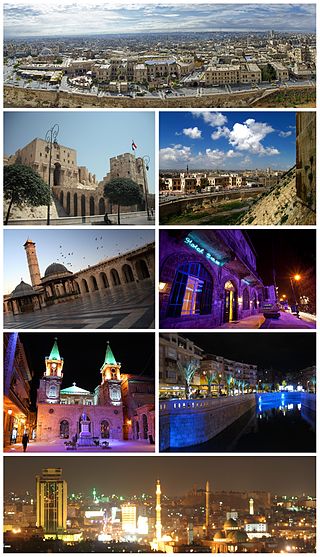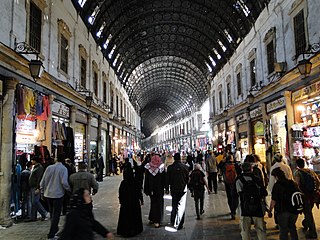
Damascus is the capital and largest city of Syria, the oldest current capital in the world and, according to some, the fourth holiest city in Islam. Known colloquially in Syria as aš-Šām (الشَّام) and dubbed, poetically, the "City of Jasmine", Damascus is a major cultural center of the Levant and the Arab world.

Homs, known in pre-Islamic times as Emesa, is a city in western Syria and the capital of the Homs Governorate. It is 501 m (1,644 ft) above sea level and is located 162 km (101 mi) north of Damascus. Located on the Orontes River, Homs is also the central link between the interior cities and the Mediterranean coast.

Aleppo is a city in Syria, which serves as the capital of the Aleppo Governorate, the most populous governorate of Syria. With an estimated population of 2,098,000 residents as of 2021, it was Syria's largest city until its population was surpassed by Damascus, the capital of Syria, and is the largest city in Syria's northern governorates and also one of the largest cities in the Levant region.

Tripoli is the largest and most important city in northern Lebanon and the second-largest city in the country. Situated 81 km (50 mi) north of the capital Beirut, it is the capital of the North Governorate and the Tripoli District. Tripoli overlooks the eastern Mediterranean Sea, and it is the northernmost seaport in Lebanon. The city is predominantly inhabited by Sunni Muslims, with smaller populations of Alawites and Christians, including Maronites and Armenians among others.

Islamic Cairo, or Medieval Cairo, officially Historic Cairo, refers mostly to the areas of Cairo, Egypt, that were built from the Muslim conquest in 641 CE until the city's modern expansion in the 19th century during Khedive Ismail's rule, namely: the central parts within the old walled city, the historic cemeteries, the area around the Citadel of Cairo, parts of Bulaq, and Old Cairo which dates back to Roman times and includes major Coptic Christian monuments.

The Al-Hamidiyeh Souq is the largest and the central souk in Syria, located inside the old walled city of Damascus next to the Citadel. The souq is about 600 metres (2,000 ft) long and 15 metres (49 ft) wide, and is covered by a 10-metre (33 ft) tall metal arch. The souq starts at Al-Thawra street and ends at the Umayyad Mosque plaza, and the ancient Roman Temple of Jupiter stands 40 feet tall in its entrance.

Khan el-Khalili is a famous bazaar and souq in the historic center of Cairo, Egypt. Established as a center of trade in the Mamluk era and named for one of its several historic caravanserais, the bazaar district has since become one of Cairo's main attractions for tourists and Egyptians alike. It is also home to many Egyptian artisans and workshops involved in the production of traditional crafts and souvenirs. The name Khan el-Khalili historically referred to a single building in the area; today it refers to the entire shopping district.

Al-Muizz li-Din Allah al-Fatimi Street, or al-Muizz Street for short, is a major north-to-south street in the walled city of historic Cairo, Egypt. It is one of Cairo's oldest streets as it dates back to the foundation of the city by the Fatimid dynasty in the 10th century, under their fourth caliph, Al-Mu'izz li-Din Allah . Historically, it was the most important artery of the city and was often referred to as the Qasaba. It constituted the main axis of the city's economic zones where its souks (markets) were concentrated. The street's prestige also attracted the construction of many monumental religious and charitable buildings commissioned by Egypt's rulers and elites, making it a dense repository of historic Islamic architecture in Cairo. This is especially evident in the Bayn al-Qasrayn area, which is lined with some of the most important monuments of Islamic Cairo.

The old city of Damascus is the historic city centre of Damascus, Syria. The old city, which is one of the oldest continuously inhabited cities in the world, contains numerous archaeological sites, including some historical churches and mosques. Many cultures have left their mark, especially Hellenistic, Roman, Byzantine and Islamic. In 1979, the historical center of the city, surrounded by walls of Roman era, was declared a World Heritage Site by UNESCO. In June 2013, UNESCO included all Syrian sites on the list of World Heritage in Danger to warn of the risks to which they are exposed because of the Syrian Civil War.

Al-Shibani Church, also known as al-Shibani School, is a 12th-century religious and cultural centre located in al-Jalloum district of the Ancient City of Aleppo, Syria. The complex is located to the west of the al-Saffahiyah Mosque and of the south of Souq Khan al-Nahhaseen.

The Ancient City of Aleppo is the historic city centre of Aleppo, Syria. Prior to the Syrian Civil War, many districts of the ancient city remained essentially unchanged since they were initially constructed between the 11th and 16th centuries. Being subjected to constant invasions and political instability, the inhabitants of the city were forced to build economically independent cell-like quarters and districts, most of which were delineated along ethnic and religious lines. These urban subdistricts, along with the ancient walled city that they surround, comprise an approximate area of 350 hectares and are home to more than 120,000 residents.
The following is a timeline of the history of the city of Damascus, Syria.
The following is a timeline of the history of the city of Cairo, Egypt.

Al-Madina Souq is the covered souq-market located at the heart of the Syrian city of Aleppo within the walled ancient part of the city. With its long and narrow alleys, al-Madina Souq is the largest covered historic market in the world, with an approximate length of 13 kilometers. It is a major trade centre for imported luxury goods, such as raw silk from Iran, spices and dyes from India and many other products. Al-Madina Souq is also home to local products such as wool, agricultural products and soap. Most of the souqs date back to the 14th century and are named after various professions and crafts, hence the wool souq, the copper souq, and so on. Aside from trading, the souq accommodated the traders and their goods in khans (caravanserais) scattered within the souq. Other types of small market-places were called caeserias (قيساريات). Caeserias are smaller than khans in size and functioned as workshops for craftsmen. Most of the khans took their names after their function and location in the souq, and are characterized by beautiful façades and entrances with fortified wooden doors.

Hammam al-Nahhasin is one of the oldest and largest public baths in Aleppo, Syria. It is located in Al-Madina Souq of the Ancient City of Aleppo, to the south of the Great Umayyad Mosque, near Khan al-Nahhasin.

The following is a timeline of the history of the city of Bursa, Turkey.
The following is a timeline of the history of the city of Hama, Syria.

Mamluk architecture was the architectural style that developed under the Mamluk Sultanate (1250–1517), which ruled over Egypt, the Levant, and the Hijaz from their capital, Cairo. Despite their often tumultuous internal politics, the Mamluk sultans were prolific patrons of architecture and contributed enormously to the fabric of historic Cairo. The Mamluk period, particularly in the 14th century, oversaw the peak of Cairo's power and prosperity. Their architecture also appears in cities such as Damascus, Jerusalem, Aleppo, Tripoli, and Medina.

The Grand Serail was the former seat of the governor of the Syrian city of Aleppo. It was built between 1928 and 1933 to serve as the main government building in the city. It was opened in 1933 during the period of the mayor Nabih Martini.
The following is a timeline of the history of the city of Homs, Syria.





















